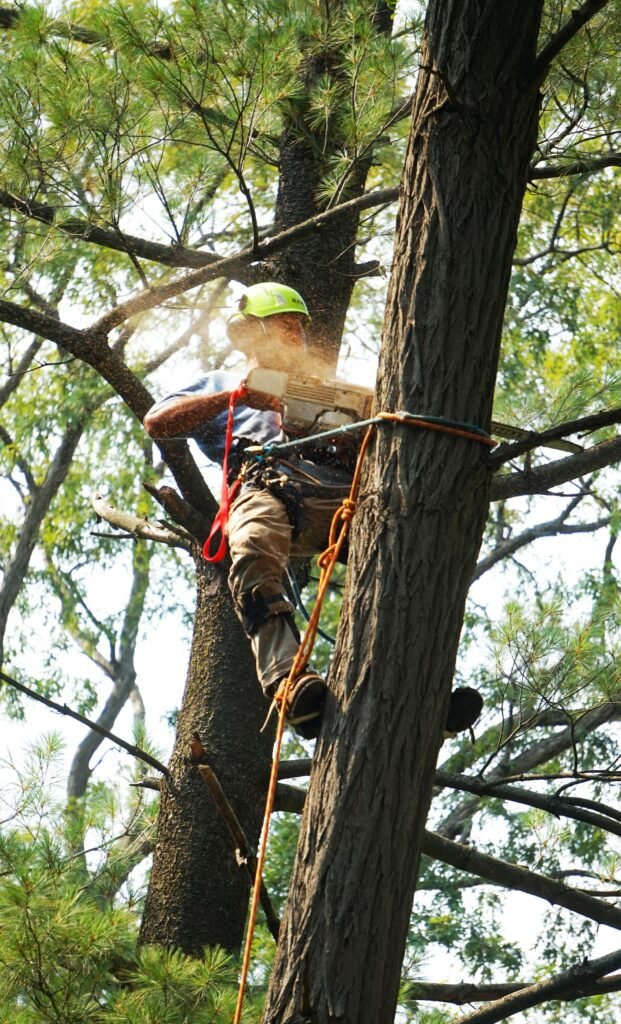Tree trimming emerges as a silent yet powerful ally. Beyond the visual allure and safety considerations linked to properly manicured trees, the act of tree trimming assumes a central role in fostering environmental health and sustainability. This article explores the environmental advantages of tree trimming, elucidating its positive impact on air quality, biodiversity, and the overarching equilibrium of ecosystems.

Improved Air Quality: The Green Lungs of Our Cities
Trees are commonly likened to the “lungs of the Earth” due to their role in absorbing carbon dioxide through photosynthesis and releasing oxygen—a vital process essential for sustaining life on our planet. Regular tree trimming enhances this natural function by promoting the growth of healthy branches and leaves, facilitating optimal photosynthesis. By maintaining the vitality of trees, trimming ensures that they continue to act as efficient carbon sinks, mitigating the impact of greenhouse gas emissions on our atmosphere.
Furthermore, the elimination of dead or diseased branches through trimming serves to avert the release of detrimental pollutants into the air. The decomposition of trees can result in the generation of volatile organic compounds (VOCs) and various other pollutants. Timely trimming arrests this process, contributing to a cleaner and healthier urban environment.
Conservation of Native Species: A Haven for Biodiversity
Tree trimming, when executed with a strategic approach, can foster biodiversity by creating an environment conducive to diverse plant and animal life. Selective pruning and trimming help maintain a balance among different species, preventing one from dominating and suppressing others. This diversity is essential for ecosystem resilience and adaptation to changing environmental conditions.
Furthermore, meticulously trimmed trees offer diverse habitats for a wide array of wildlife. Birds, insects, and other organisms discover refuge, nesting spots, and sources of sustenance within the branches and foliage of trees. By promoting the health of trees through trimming, we indirectly support the web of life that relies on these green havens.
Halting the Proliferation of Pests and Diseases: A Forward-Thinking Strategy
Untended trees are more prone to infestations by pests and diseases. Insects and pathogens often target weakened or dead branches, using them as entry points to invade the tree’s core. Regular trimming removes these vulnerable parts, acting as a proactive measure to curb the spread of pests and diseases.
Through averting the onset of infestations, tree trimming diminishes the necessity for chemical interventions, fostering a more sustainable and environmentally friendly approach to tree care. This not only safeguards the health of individual trees but also protects the broader ecosystem from the potential negative impacts of chemical treatments.
Mitigating Storm Damage: Protecting the Urban Landscape
Storms and severe weather events have the potential to unleash havoc on trees, causing shattered branches, uprooted trunks, and extensive damage. Untrimmed trees, especially those with overgrown canopies, are more susceptible to such damage. Regular trimming, however, helps create a well-balanced and structurally sound tree canopy that can withstand the forces of nature more effectively.
In the aftermath of storms, prompt tree trimming is crucial for removing damaged or fallen branches, minimizing the risk of secondary impacts. This proactive approach not only aids in the swift recovery of urban landscapes but also prevents potential hazards, ensuring the safety of residents and property.
Enhancing Urban Aesthetics: A Green Oasis Amidst Concrete
While the environmental benefits of tree trimming are profound, it’s essential not to overlook its role in enhancing the overall aesthetics of urban spaces. Well-maintained trees contribute to the beauty of parks, streets, and neighborhoods, creating green havens that offer respite from the concrete jungle. This aesthetic appeal has a psychological impact, promoting mental well-being and fostering a deeper connection between individuals and their environment.
In conclusion, the environmental benefits of tree trimming extend far beyond the cosmetic. By actively participating in the care and maintenance of our urban forests, we contribute to a healthier planet. From purifying the air we breathe to providing habitats for diverse wildlife, tree trimming stands as a testament to our commitment to environmental harmony. As we continue to explore sustainable practices, let us not underestimate the role of this seemingly simple act in building a greener, more resilient future for generations to come.